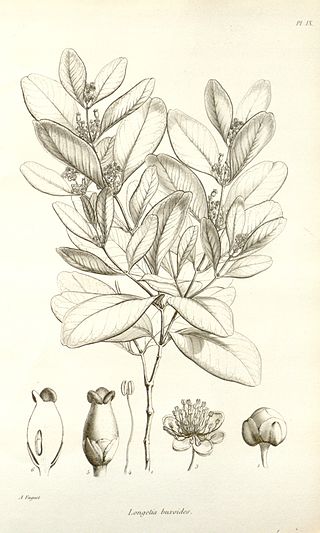
Austrobuxus is a genus of plants under the family Picrodendraceae first described as a genus in 1861. It is native to Southeast Asia, Papuasia, and Australia. The region with the highest diversity is New Caledonia.
Neoroepera is a genus of plants in the Picrodendraceae first described as a genus in 1866. The entire genus is endemic to the State of Queensland in northeastern Australia.
- Neoroepera banksiiBenth. - Shire of Cook
- Neoroepera buxifoliaMüll.Arg. - Gladstone District

Petalostigma is a genus of plants under the family Picrodendraceae and the monogeneric subtribe Petalostigmatinae, first defined by von Mueller in 1857. It is native to New Guinea and Australia. They are evergreen, dioecious shrubs or trees.

Longetia is a genus of plants under the family Picrodendraceae first described as a genus in 1866. It has only one known species, Longetia buxoides, endemic to New Caledonia.
Scagea is a genus of plants under the family Picrodendraceae described as a genus in 1986.
Aristogeitonia is a plant genus in the family Picrodendraceae, described as a genus in 1908. It is native to Africa and Madagascar.
- Aristogeitonia gabonica - Gabon
- Aristogeitonia limoniifolia - Angola
- Aristogeitonia lophirifolia - Madagascar
- Aristogeitonia magnistipula - Tanzania
- Aristogeitonia monophylla - Tanzania, Kenya
- Aristogeitonia perrieri - Madagascar
- Aristogeitonia uapacifolia - Toliara Province
Stachyandra is a plant genus in the family Picrodendraceae first described as a genus in 1990.
Parodiodendron is a monotypic plant genus under the family Picrodendraceae, described as a genus in 1969. The sole species is Parodiodendron marginivillosum(Speg.) Hunz..

Piranhea is a plant genus under the family Picrodendraceae described as a genus in 1866.

Tetracoccus is a plant genus under the family Picrodendraceae. Shrubby-spurge is a common name for plants in this genus. They are dioecious, often hairy shrubs.
Apodiscus is a genus of trees belonging to the family Phyllanthaceae first described as a genus in 1912. It contains only one known species, Apodiscus chevalieri, native to tropical West Africa.

Pseudolachnostylis is a genus of plants in the family Phyllanthaceae first described as a genus in 1899. It contains only one known species, Pseudolachnostylis maprouneifolia native to central and southern Africa. Its common name is kudu berry, though the term also applies for Cassine aethiopica. In Zimbabwe it is called mutsonzowa (Shona) or Umqobampunzi (Ndebele).
Heywoodia is a genus of plants in the Phyllanthaceae first described as a genus in 1907. It contains only one known species, Heywoodia lucens, native to eastern, southeastern, and southern Africa.

Dioscorea oppositifolia is a type of yam (Dioscorea) native to Myanmar (Burma) and to the Indian Subcontinent.
Ochthochloa is a genus of desert plants in the grass family native to the Sahara and Arabian Deserts. The only known species is Ochthochloa compressa, whose native range extends from Algeria to Uttarakhand.

The World Checklist of Selected Plant Families was an "international collaborative programme that provides the latest peer reviewed and published opinions on the accepted scientific names and synonyms of selected plant families." Maintained by the Royal Botanic Gardens, Kew, it was available online, allowing searches for the names of families, genera and species, as well as the ability to create checklists.

Dactyladenia is a genus of plants in the family Chrysobalanaceae. They are distributed in western and central Africa, from Liberia to Angola. There are about 31 species.
Choriceras is a genus of plants in the family Picrodendraceae first described as a genus in 1874.

Maundia is a genus of alismatid monocots, described in 1858. Maundia was formerly included in the family Juncaginaceae but is now considered to form a family of its own under the name Maundiaceae. It contains only one known species, Maundia triglochinoides, endemic to Australia.

Vitellariopsis marginata is a species of plant in the family Sapotaceae. It is native to Mozambique, South Africa, and Eswatini.










